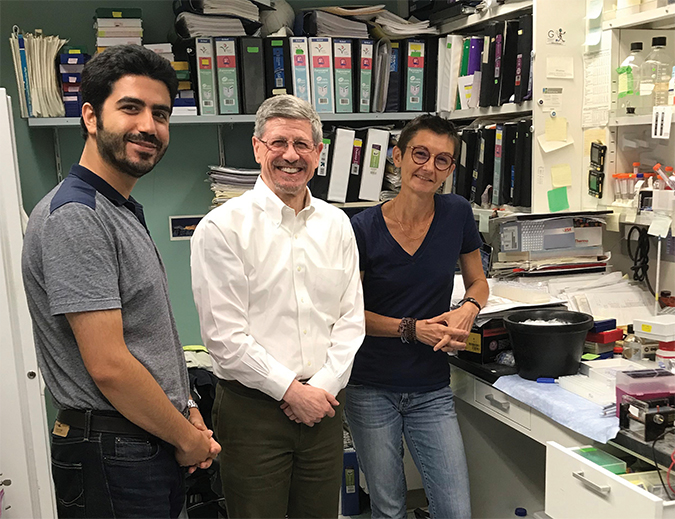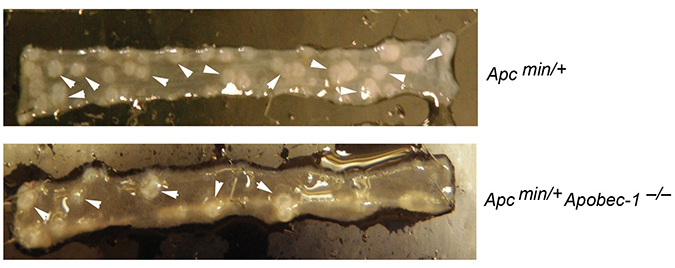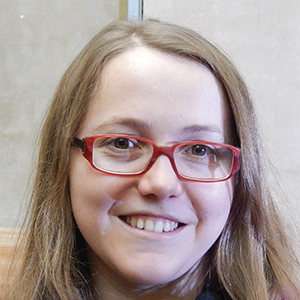Chasing the diagnostic potential of RNA editing
Nicholas O. Davidson wears many hats: He is a practicing physician, he is the division chief of gastroenterology at Washington University in St. Louis, and he holds professorships in medicine, developmental biology, and pharmacology and molecular biology. On top of that, he is the co-editor-in-chief of the Journal of Lipid Research and a principal investigator studying the genetic regulation of intestinal and hepatic lipid homeostasis, with authorship on more than 230 papers.
A recent paper by Davidson and colleagues, published in RNA Journal, deepens our understanding of tissue-specific regulation of programmed alteration of RNA, known as RNA editing, in the intestine and the liver.
“This paper identifies what we believe to be the complete machinery for a form of RNA editing,” Davidson said. “The approaches and the tools from this study can be applied to gain a better understanding of the function of most, if not all, types of mammalian cells.”
Davidson’s professional journey and scientific outlook was captured in ASBMB Today in a 2012 interview. In brief, his interest in gastroenterology emerged during his medical training at Kings College Hospital Medical School in London under the mentorship of Roger Williams, one of the trailblazers of liver transplantation. He further built his expertise by working with the late Pete Ahrens Jr. at The Rockefeller University in New York and during a gastroenterology fellowship at Columbia–Presbyterian Medical Center. His own lab started at the University of Chicago Medical Center before relocating to St. Louis. His research has helped shape the field of RNA editing over several decades.
 The RNA editing team in the Davidson lab at Washington University in St. Louis include, from left, Saeed Soleymanjahi, Nick Davidson and Valerie Blanc.Courtesy of Nick DavidsonRNA editing can create heterogeneity in genetically identical cells by mediating amino acid substitutions, alternative isoform creation and modification of stop codons. Furthermore, RNA editing in the 3’-untranslated region has been shown to be the alteration that most frequently leads to changes in RNA stability, RNA localization and protein translation. Advances in high-throughput sequencing techniques have shown that RNA-editing events are more pervasive than originally thought, prompting the introduction of the concept of an epitranscriptomic code to parallel the epigenetic code.
The RNA editing team in the Davidson lab at Washington University in St. Louis include, from left, Saeed Soleymanjahi, Nick Davidson and Valerie Blanc.Courtesy of Nick DavidsonRNA editing can create heterogeneity in genetically identical cells by mediating amino acid substitutions, alternative isoform creation and modification of stop codons. Furthermore, RNA editing in the 3’-untranslated region has been shown to be the alteration that most frequently leads to changes in RNA stability, RNA localization and protein translation. Advances in high-throughput sequencing techniques have shown that RNA-editing events are more pervasive than originally thought, prompting the introduction of the concept of an epitranscriptomic code to parallel the epigenetic code.
In 1994, Davidson’s team showed that one mechanism of RNA editing is the deamination of cytosine to uracil, which is catalyzed by the Apobec family, including Apobec-1. Other researchers later discovered that the Apobec-1 biochemical function requires a cofactor, and two different essential cofactors were discovered — Apobec-1 complementation factor, or A1cf, and RNA binding motif protein 47, or Rbm47.
Prior to this paper, the relative contribution of the two cofactors to physiological Apobec-1 function was not fully understood. Davidson’s team looked at the global RNA-editing landscape of mouse livers and intestines when either or both cofactors were deleted or were overexpressed as transgenes. Deletion of Rbm47, but not A1cf, caused a large, tissue-specific change in the RNA editing profile, with the intestines being most affected.
“The findings of this paper were somewhat surprising, since A1cf was discovered as necessary for the deaminase Apobec-1 to act on RNA, and it was originally thought to be the Apobec-1 cofactor,” Davidson said. “However, our data using a conditional tissue-specific deletion of Rbm47 alone or with A1cf point to Rbm47 as the dominant Apobec-1 cofactor in adult mouse liver and intestine.”
Davidson’s lab now is using the genetic tools from this study to illuminate further the role of RNA editing during development, where it is implicated in regulation of growth.
RNA-editing alterations also have been reported in cancers and neurological disorders, and Davidson’s lab is pursuing the profiling of DNA, RNA and protein levels in cancer tissues to substantiate further the diagnostic potential of RNA editing.
“This study fits into the emerging consensus in cancer biology that RNA editing can contribute to cancer susceptibility,” he said, “and this is a big direction that we are focusing on.” Apcmin/+ is a mouse model for tumorigenesis. The top image shows a representative section of the intestine of an Apcmin/+ mouse. Arrows denote some of the many polyps. Deletion of the RNA-editing enzyme Apobec-1 in this model drastically reduces the number of polyps in the intestine. The Davidson lab is exploring how loss of cytosine to uracil RNA editing protects against intestinal tumorigenesis.Courtesy of Nick Davidson
Apcmin/+ is a mouse model for tumorigenesis. The top image shows a representative section of the intestine of an Apcmin/+ mouse. Arrows denote some of the many polyps. Deletion of the RNA-editing enzyme Apobec-1 in this model drastically reduces the number of polyps in the intestine. The Davidson lab is exploring how loss of cytosine to uracil RNA editing protects against intestinal tumorigenesis.Courtesy of Nick Davidson
Enjoy reading ASBMB Today?
Become a member to receive the print edition four times a year and the digital edition monthly.
Learn moreGet the latest from ASBMB Today
Enter your email address, and we’ll send you a weekly email with recent articles, interviews and more.
Latest in Science
Science highlights or most popular articles

Mining microbes for rare earth solutions
Joseph Cotruvo, Jr., will receive the ASBMB Mildred Cohn Young Investigator Award at the ASBMB Annual Meeting, March 7–10, just outside of Washington, D.C.

Fueling healthier aging, connecting metabolism stress and time
Biochemist Melanie McReynolds investigates how metabolism and stress shape the aging process. Her research on NAD+, a molecule central to cellular energy, reveals how maintaining its balance could promote healthier, longer lives.

Mapping proteins, one side chain at a time
Roland Dunbrack Jr. will receive the ASBMB DeLano Award for Computational Biosciences at the ASBMB Annual Meeting, March 7–10, just outside of Washington, D.C.

Exploring the link between lipids and longevity
Meng Wang will present her work on metabolism and aging at the ASBMB Annual Meeting, March 7-10, just outside of Washington, D.C.

Defining a ‘crucial gatekeeper’ of lipid metabolism
George Carman receives the Herbert Tabor Research Award at the ASBMB Annual Meeting, March 7–10, just outside of Washington, D.C.

The science of staying strong
Muscles power every movement, but they also tell the story of aging itself. Scientists are uncovering how strength fades, why some species resist it and what lifestyle and molecular clues could help preserve muscle health for life.

